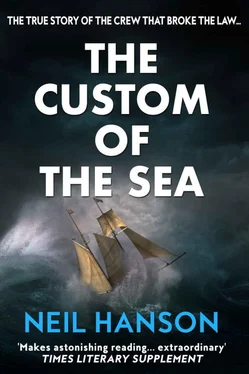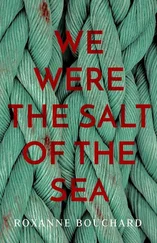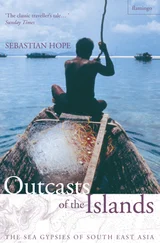No further word was exchanged, but Stephens looked down at the boy and nodded. Both then turned towards Brooks. He hesitated, then bowed his head.
‘Who is to do it?’
‘I cannot,’ Brooks said.
Stephens shook his head. ‘Nor I.’
‘Then I shall have to,’ Tom said.
He stared at Brooks. ‘You had better go forward and have a rest. Stephens, take over the watch.’
Stephens took the steering oar, while Brooks moved towards the bow and lay down, once more hiding his face under the canvas sheet.
Shading his eyes against the glare of the burning sun, Tom took hold of the shrouds and pulled himself up to search the horizon all around them for any trace of a ship. Nothing broke the glassy surface of the sea.
He remained motionless for a moment, offering a prayer for the boy’s soul, and asking forgiveness of his Maker. Then he placed the chronometer case next to Richard’s head, took out his knife and opened the blade. The sunlight glinted from the blue steel.
He glanced towards Stephens. ‘Hold the boy’s legs if he struggles.’
Richard had appeared to be unconscious but his eyes flickered open at the words. His pupils had lost almost all their pigment and were the colour of skimmed milk. Tom doubted whether he could even still see.
‘What — me, sir?’ he said.
Tom made no reply. He placed the knife against the boy’s neck. Trying to close his mind to what he was about to do, he began reciting under his breath the instructions in The Steward’s Handbook that he had been forced to learn years before on his first voyage as cook-steward. ‘“Proceed immediately to bleed the beast. This is done by cutting up the gullet and severing the arteries and veins on each side of the neck, near to the head. The blood will now flow out quite freely.”’
He took a handful of the boy’s hair in his left hand, holding his head still against the boards, then plunged the knife into his neck. He jerked the blade sideways, severing an artery and slicing into the windpipe, then dropped the knife and held the metal bowl against Richard’s neck.
The boy did not even cry out, but as blood began to pump from the wound in a slow, palsied beat, his arms flailed and a terrible, wet sucking sound came from his torn windpipe. His white eyes stared sightlessly up at Tom.
He tried to shut his ears to the sound of the boy’s death throes, but they echoed in his mind long after the noises had at last ceased and the twitching body lay still. Only a dribble of blood still flowed from the wound.
The blood he had collected in the chronometer case was thick and viscous and already beginning to congeal. They began to drink it in turn. Brooks scrambled from under his canvas cover. ‘Give me a drop of that,’ he said, and they shared it with him.
As soon as they had finished the blood, Tom and Stephens stripped the clothes from the boy’s body. Tom then pushed the knife into the stomach just below the breastbone and forced it downwards, opening a deep slit in Richard’s belly. Even strengthened a little by the blood, he was so weak and slow that the cut seemed to take minutes to complete.
He paused, his breath coming in hoarse gasps. ‘“Now make a slit in the stomach and run the knife right up to the tail. Remove the fat from round the intestines and then pull out the intestines, paunch, and liver. Cut the gall bladder off the liver right away. Turn the kidney fat over and remove the kidneys. Now cut through the diaphragm, commonly called the skirt, which separates the organs within the chest from the intestines, and remove the lungs, heart, and thorax.”’
He reached into the still warm chest cavity and pulled out the heart and liver. He put them in the chronometer case and cut them up. The three men ate them ravenously, squabbling over the pieces like dogs.
When they had eaten the last scrap, Tom raised his gaze from the bloodstained bowl and stared at the others. Their faces were smeared with blood and their eyes were wild. He shuddered, knowing that his own visage was no different, but he could already feel strength flowing back into his body. ‘“When this has all been done, get some warm water and wash out the carcass, and any blood that may be on it must be washed off.”’
He leaned over the gunwale and rinsed the blood from his face, then sent Brooks aft to steer the boat while Stephens helped him to butcher the body. Not wanting to see the dead boy’s face in front of him as he worked, Tom first cut off the head and threw it overboard. His fingers slippery with blood, he worked as fast as he could, hacking off strips of flesh, which Stephens washed in the sea and laid across the cross-beams to dry.
At first Tom used the wooden cross-member as a butcher’s block, but fearing that he might further damage the boat’s thin planking as he hacked and sawed at the body with his knife, he did the heavier cutting — parting the joints and severing the tendons — against the brass crutches of the oars. It took three hours to complete the grisly task.
The larger bones, and Richard’s feet, genitals and intestines, were also thrown overboard. They looked on in horror as, astern of the boat, sharks thrashed the water into a pink froth, fighting over the bloody fragments. One was bitten in the head by a larger shark as they fought over some part of the body. In an instant, every one of the pack of sharks circling the remains had turned on the wounded creature. It was ripped apart in little more than a minute.
Even when the blood and entrails had been consumed or dissipated by the waves, sharks continued to track the dinghy. A fin showed above the water from time to time and there was a grinding thud as one broke surface right alongside the dinghy, sending it crabbing sideways. Tom tried to drive it off by hitting it with an oar, but already weak and further exhausted by his struggle to butcher the carcass, he barely had the strength to raise it above his head.
Brooks took over, and though he did not manage to hit the shark, the noise of the oar banging on the water was enough to scare it off. From time to time they glimpsed the sharks astern of the dinghy, and even when unseen, all of them continued to fear their presence.
Survival cannibalism has occurred throughout human history. Some skeletons of Peking man and Neanderthal man show evidence of it in the gnawed and split bones, and the cerebral cortices on the skulls, artificially enlarged to enable the brains to be extracted.
The Greek historian Herodotus wrote of anthropophagi among the people beyond the Caspian Sea, and an Egyptian physician, Abd al-Latif, witnessed widespread cannibalism around Misr and Cairo during the great famine of AD 1201:
The poor, under the pressure of ever-growing want, ate carrion, corpses, dogs, excrement and animal dung. They went further and reached the stage of eating little children… The commandant of the city guard ordered that those who committed this crime should be burned alive… The corpse was always found to have been devoured by the following morning. People ate it the more willingly, for the flesh, being fully roasted, did not need to be cooked…
The custom being once introduced, spread in the provinces so that there was no part of Egypt where one did not see examples of it. Then it no longer caused surprise. The horror people had felt at first entirely vanished; one spoke of it, and heard it spoken of, as a matter of everyday indifference.
Ritual cannibalism was also widely practised across the globe until the nineteenth and even twentieth centuries. Human flesh was usually eaten not from physical necessity but to absorb the courage and intelligence of an opponent — the heart and brains were the most frequently consumed body parts — or as the last act in the humiliation of an enemy, though some Australian Aborigines ate dead relatives as a mark of respect.
Читать дальше











